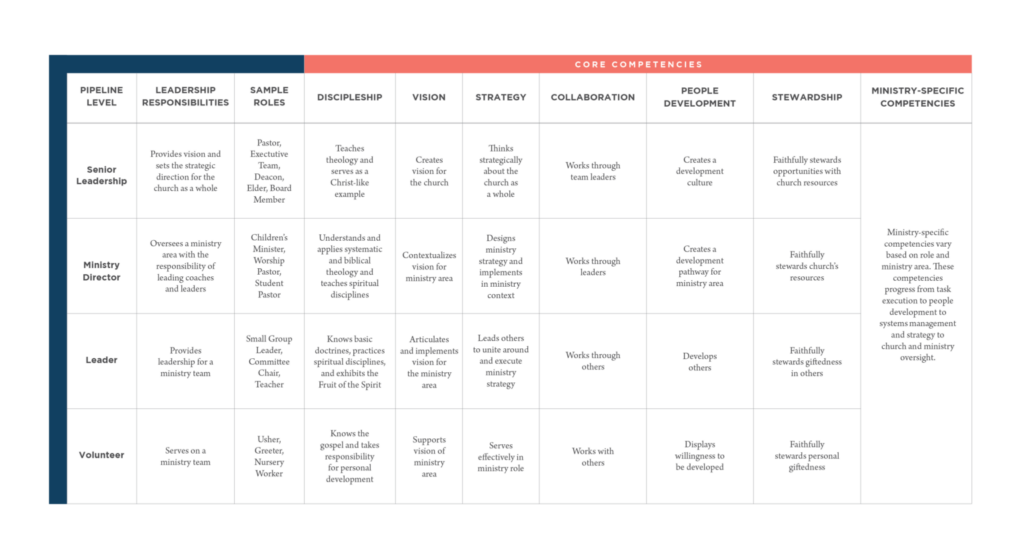You need a leadership pipeline to scale leadership development. Wise leaders insist on having systems for what is important. If church leaders believe following up on guests or givers is important, then they put a system in place to ensure it happens. If marketplace leaders believe that annual goal setting or financial scenario planning is an important discipline in their business, then they put a system in place to ensure they happen. Quite simply, a leadership pipeline is a system for those who believe leadership development is important enough to happen at scale. Here is a sample leadership pipeline (click the image to enlarge it and make the text more readable):

What I Appreciate About This Framework
A decade ago, one of my good friends, Todd Adkins, convened a group of leaders who excel in developing others. The goal of the meeting was to determine what should be developed in young and emerging leaders. You have to know what competencies you are seeking to develop so you can plan with those in mind. If you don’t know what you are developing people for, then leadership development will be non-existent at worst and haphazard at best. After days of discussing, debating, and whittling a long list of attributes down, the group decided on these. You can of course come up with your own, but I appreciate the framework because I know the leaders and the process that concluded we must develop leaders for discipleship, vision, strategy, stewardship, collaboration, and people development.
How to Use This Framework
A blank sheet of paper is often paralyzing, so use this framework to get you started on developing a leadership pipeline. Your leadership pipeline does not have to be perfect, and you won’t execute it perfectly. Think of a coach who calls a play. The team may not execute the play perfectly, but it is better than not calling a play because that would be utter chaos. The two basic components of a leadership pipeline are the who and the what. Who will be developed? What will they be developed for?
- The who: levels of leaders
On the left side of a dry erase board or a large sheet of paper, list the different levels of leadership within the organization. Something like: volunteer, leader, coach, senior coach. You likely already have these, and you will find that it is wise to use the same nomenclature across the entire ministry or organization.
- The what: competencies
On the top of the dry erase board or large sheet of paper, list the competencies you will develop people around. For example, here are the ones we use: vision, strategy, discipleship, collaboration, stewardship, and people development.
Now draw horizontal and vertical lines to create boxes for each level of leadership and competency. Then begin the discussion around what each competency should look like for each level of leadership and what training can be assigned. You likely already have some of the training or programs within your weekly schedule, and you are wise to use everything you are already offering before creating new content and opportunities.
You’re done! Just joking, but this is a really good start. As with all the systems you have for really important values within your context, you will keep tweaking the system because you care for the people it helps you serve.
How This Framework Has Helped Me
Having a leadership pipeline beneath the surface has helped me think about succession for all types of roles. Instead of reactively scrambling to “fill a spot,” a leadership pipeline helps leaders think proactively about the future. Without a leadership pipeline, leaders likely approach leader deployment from a reactive posture rather than a proactive one. The framework has also helped me in identifying leaders to tap for new projects or initiatives as opportunities for them to be developed and the mission to be expanded.
Attached is a PDF of a pipeline framework I use to get conversations started. It is also in the book Designed to Lead.






